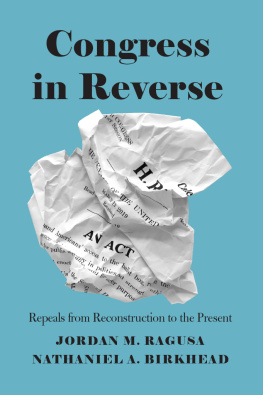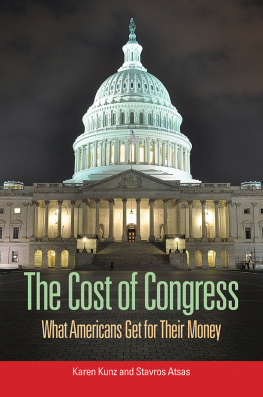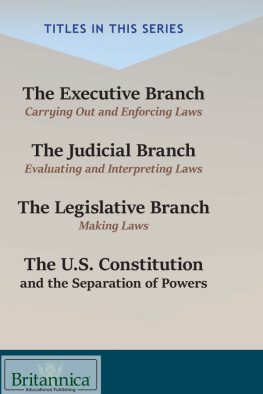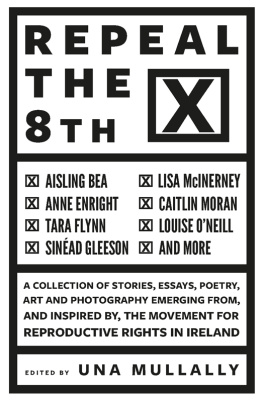The University of Chicago Press, Chicago 60637
The University of Chicago Press, Ltd., London
2020 by The University of Chicago
All rights reserved. No part of this book may be used or reproduced in any manner whatsoever without written permission, except in the case of brief quotations in critical articles and reviews. For more information, contact the University of Chicago Press, 1427 E. 60th St., Chicago, IL 60637.
Published 2020
Printed in the United States of America
29 28 27 26 25 24 23 22 21 20 1 2 3 4 5
ISBN -13: 978-0-226-71733-3 (cloth)
ISBN -13: 978-0-226-71747-0 (paper)
ISBN -13: 978-0-226-71750-0 (e-book)
DOI: https://doi.org/10.7208/chicago/9780226717500.001.0001
Library of Congress Cataloging-in-Publication Data
Names: Ragusa, Jordan M., author. | Birkhead, Nathaniel, author.
Title: Congress in reverse : repeals from Reconstruction to the present / Jordan M. Ragusa and Nathaniel A. Birkhead.
Description: Chicago ; London : The University of Chicago Press, 2020. | Includes bibliographical references and index.
Identifiers: LCCN 2019052055 | ISBN 9780226717333 (cloth) | ISBN 9780226717470 (paperback) | ISBN 9780226717500 (ebook)
Subjects: LCSH : Repeal of legislationUnited States. | Repeal of legislationUnited StatesHistory. | United States. Congress.
Classification: LCC KF 4945 . R 34 2020 | DDC 328.73/077dc23
LC record available at https://lccn.loc.gov/2019052055

This paper meets the requirements of ANSI/NISO Z 39.48-1992 (Permanence of Paper).
When and Why Repeals Occur
In the 2008 campaign, candidate Barack Obama promised to deliver affordable, accessible health care for every single American. Upon taking office, Obama invited his Democratic allies in Congress to take the lead in creating the new law. After all, Democratic lawmakers had begun work on health care reform long before Obama took office. With a first-term president, majorities in both chambers, and the ability to circumvent a Republican filibuster via reconciliation in the Senate, health care reform could be achieved in the 111th Congress (200911) with Democratic votes alone.
Democrats ultimately succeeded in their effort to expand national health insurance coverage in March of 2010. At the White House signing ceremony, Vice Present Joe Biden was caught on camera saying This is a big f**king deal. Yet lost in celebration that day was the fact that the Affordable Care Acts (ACAs) fate was far from certain. In fact, the day before the law was enacted, with Democrats still in control of both chambers, Republicans introduced three repeal bills in the House and one repeal bill in the Senate. Needless to say, these bills had no chance of passing either chamber. Later, after winning control of the House in the 2010 midterm, Republicans in the 112th and 113th Congresses (201115) passed dozens of ACA repeal bills in the lower chamber. Predictably, these bills died in the Senate, which remained under Democratic control. But once the GOP gained control of the Senate in the 114th Congress (201517), Republicans employed the same reconciliation procedure Democrats used to circumvent a filibuster in 2010 and, for the first time, passed a single repeal bill in both chambers. Although Obamas veto was inevitable, the bills passage represented a significant milestone because it demonstrated the viability of the GOPs repeal efforts under the right institutional conditions. As Speaker of the House Paul Ryan explained, Now, is someone named Obama going to sign a bill into law repealing Obamacare? Of course not. But we have now demonstrated that, if we elect a Republican president, we can use this same path to repeal Obamacare without 60 votes in the Senate.
In the 2016 campaign, candidate Donald Trump promised, When we win on November 8th and elect a Republican Congress, we will be able to immediately repeal and replace Obamacare. Upon taking office, Trump invited his Republican allies in Congress to take the lead in repealing the law. After all, Republican lawmakers had begun work on repealing the ACA long before Trump took office. With a first-term president, majorities in both chambers, and the ability to circumvent a Democratic filibuster via reconciliation in the Senate, an ACA repeal could be achieved in the 115th Congress (201719) with Republican votes alone.
In September of 2017, following a seven-year effortconsisting of countless campaign pledges, dozens of proposals, and approximately one hundred votesthe Republican Party failed in their effort to repeal the ACA despite the same institutional conditions that saw Democrats successfully enact the law. In this respect, unified party control was not sufficient for Republicans to repeal the health care reform law, despite the predictions of countless observers, including Donald Trump and many GOP lawmakers. However, Republicans did succeed in repealing a portion of the ACAthe individual mandatewhen they enacted a sweeping tax reform bill in December of that year.
Given the ACAs passage and postpassage history, it seems safe to conclude that repeals defy easy explanation. It is difficult to overstate: the GOPs inability to repeal the ACA despite an intense multiyear effort is one of the most notable political events in recent political history. Further complicating matters is the fact that in the 1990s, the Republican Party succeeded in repealing a number of major statutesthe Glass-Steagall Act, Aid to Families with Dependent Children (AFDC), and the National Maximum Speed Laweven with Bill Clinton, a Democrat, opposing their repeal in the White House. In this book, we hope to make sense of the puzzle described above and understand when and why repeals occur. In doing so, we seek to answer the following questions:
- (1) Are law creation and law repeal mirror opposites of one another? Given the GOPs failure to repeal the bulk of the ACA, despite the same institutional conditions as at the time of the laws enactment, the answer may be no even though law creation and law repeal are subject to the same legislative procedures and constitutional requirements.
- (2) What factors make repeal more likely in some Congresses? Because the Republican Party succeeded in passing a number of notable repeals in the 1990s, under divided government, but repealed few laws in the 2000s, with unified control, it would seem that the majoritys capacity to repeal legislation waxes and wanes over time.
- (3) Why are some statutes more likely to be repealed? Given the repeal of the ACAs individual mandatea tax provisiondespite the failure to repeal the laws health care provisions, some statutes seem to be more durable than others.
- (4) Can existing theories of the legislative process make sense of when and why repeals occur? Although legislative scholars focus almost exclusively on the factors that lead to the creation of new laws, perhaps one or more of the literatures leading theories explain repeals as well.
Fundamental Questions
Why Study Repeals?
Studying repeals is worthwhile for two primary reasons. First, repeals are substantively important. As a policy matter, repeals often represent decades-long efforts to reshape the nations laws, and when they succeed, repeals make dramatic changes to the nations policies and programs. As a political matter, repeal efforts often hinge on the key issues of the day and are usually, though not always, contentious. Readers familiar with American political history will recognize many of the successful repeals that we discuss in this book, including the Tenure of Office Act in 1887; multiple monetary statutes in the 1890s; the gold standard in 1933; the Chinese Exclusion Acts in 1943; the Gulf of Tonkin Resolution in 1970; multiple New Deal statutes, including AFDC and Glass-Steagall, in the 1990s; and Dont Ask, Dont Tell in 2010.









 This paper meets the requirements of ANSI/NISO Z 39.48-1992 (Permanence of Paper).
This paper meets the requirements of ANSI/NISO Z 39.48-1992 (Permanence of Paper).